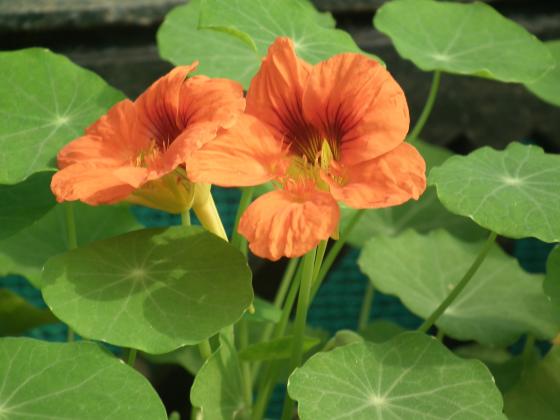Tropaeolum majus - Do you see flashes of light in your garden?
Backyard Horticulture
Tropaeolum majus, nasturtium, is a flowering plant native to South and Central America. The varieties I’ve seen in Texas have been 8 to 12 inches tall. Leaves are round. Flower colors vary but often range from dark yellow to orange. They are fragrant, about one to two inches across with five petals, two at the top and three on the bottom. The fruit is less than 1 inch with three-segments, each with one seed about ⅓ inch.
High in vitamin C, all parts are edible. Flowers and leaves make a peppery salad addition. The spicy smell and taste are from the plant’s mustard oil. The word nasturtium in Latin means “nose twister” referring to the pungent oil. Seeds can be pickled and used like capers or ground as a pepper substitute. Leaves are stuffed. You can make nasturtium pesto. T. majus is in the Food and Drug Administration Poisonous Plant Database at fda.gov.
Nasturtium is anti-bacterial and anti-fungal. Medicinally it’s used for congestion, urinary tract infections, etc. Wikipedia’s article, “Tropaeolum”, at en.wikipedia.org says, “In Germany, licensed physicians are allowed to prescribe the herbal antibiotic, Angocin Anti-Infekt N, made from only nasturtium and horseradish root.”
The National Institutes of Health, ncbi.nlm.nih.gov, has nasturtium articles. One is “Garden nasturtium (Tropaeolum majus L.) - a source of mineral elements and bioactive compounds”.
PubAg, pubag.nal.usda.gov, is the U.S. Department of Agriculture, National Agricultural Library’s search system for agricultural information. One of their articles is “Comparison of antioxidant, anti-inflammatory, antimicrobial activity and chemical composition of aqueous and hydroethanolic extracts of the herb of Tropaeolum majus L.”.
The plant provides food for moths. Organic gardeners plant nasturtiums with their vegetables because the plant repels many pest insects. But it also acts as a trap crop by attracting predatory insects.
There is an optical phenomenon that sometimes at dusk nasturtium’s orange flowers appear to emit light flashes. It’s called the Elizabeth Linnaeus Phenomenon, named for the daughter of the famous Swedish botanist Carl Linnaeus (1707-1778). With no formal education, she described it in a paper for the Royal Swedish Academy of Sciences in 1762 when she was 19. At the time it was thought to be an electrical phenomenon. In 1914 a German scientist showed the phenomenon was the result of the way our eyes perceive the flowers’ colors in the twilight. For more information see the New York Botanical Gardens’ article “Flashes in the Twilight” at nybg.org.
Deborah Richardson is a freelance reporter for The Examiner with a fondness for flora in its natural setting.



